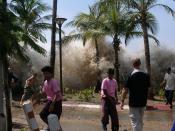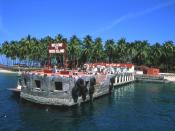On 26th December 2004, a 'tsunami' devastated the coasts of South-East Asia. Could anything have been done to prevent or mitigate this disaster? Discuss the response from the rest of the world and the political repercussions of this catastrophe.
On the 26th of December 2004 an earth quake off the coast of Indonesia caused a tsunami which struck the coastline of 17 nations in Southeast Asia (2004 Tsunami Map, 1). Causing thousands to be killed and displaced from their homes, the devastation stretched from Sumatra to Somalia. This has been the greatest natural disaster of our time, killing more than 300,000 people and overwhelming thousands of square kilometres of land. Its waves reached the astounding height of 30 meters.
Indonesia suffered the highest death toll; various coastal villages were wiped out, and more than 70% of their population was killed. Sri Lanka was one of the most devastated countries together with Indonesia.
India's southeast coastlines were also greatly affected by the tsunami, and in India alone a present estimation of more than 16,400 people were killed (2004 Tsunami Map, 1). India's Andaman and Nicobar islands, these islands were literally destroyed by the tsunami, large numbers of people died and the ecosystem was severely damaged by the waves. Thailand saw its west coast destroyed larger number of tourists of over 36 countries died. Maldives, whole islands have been damaged. Malaysia was protected by Sumatra so the impact was reduced although people were swiped of the shore. Bangladesh, Kenya, Tanzania and Seychelles have the lowest death tolls but have also suffered losses due to the tsunami. Somalia was the most affected country is Africa reporting an estimated death toll of over 290 people.
After a disaster of such magnitude takes place the question on people's minds is, how could...


